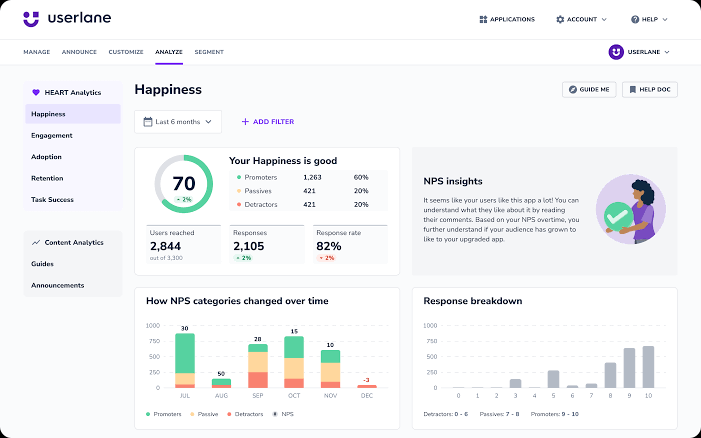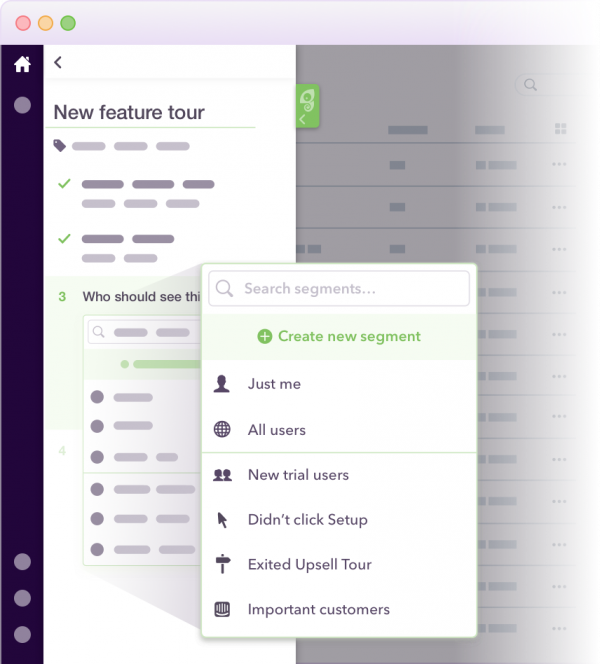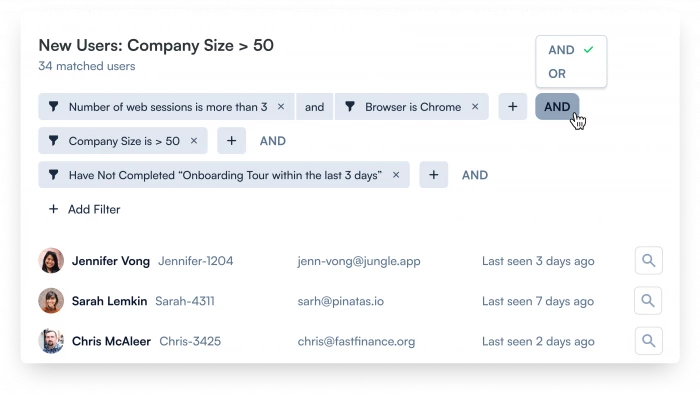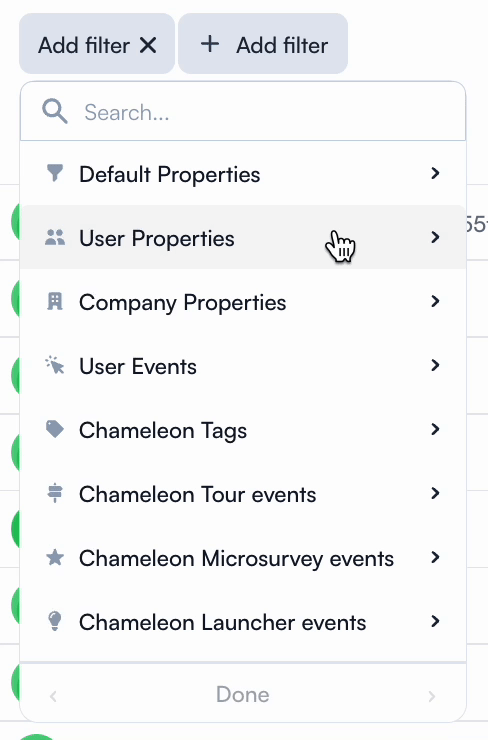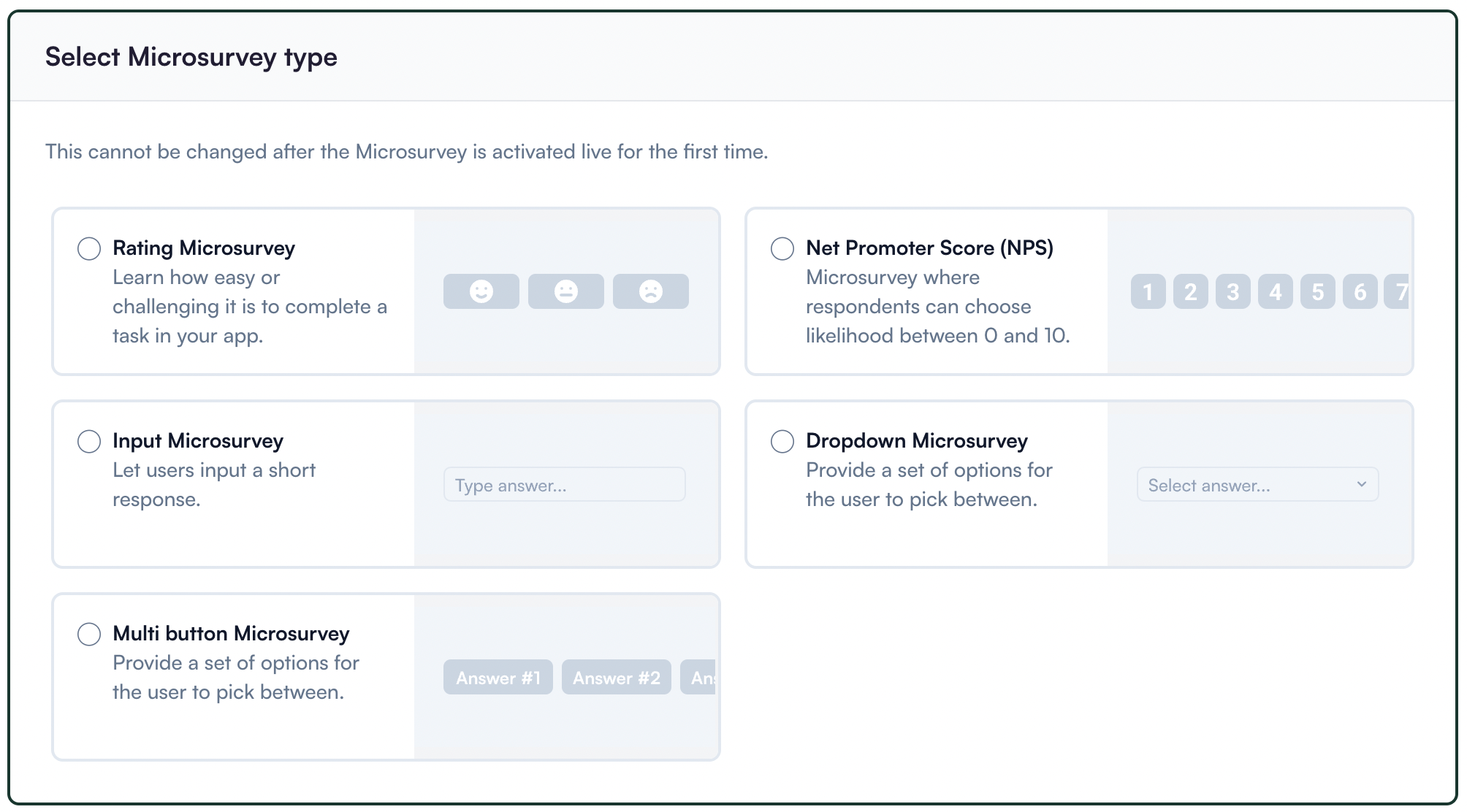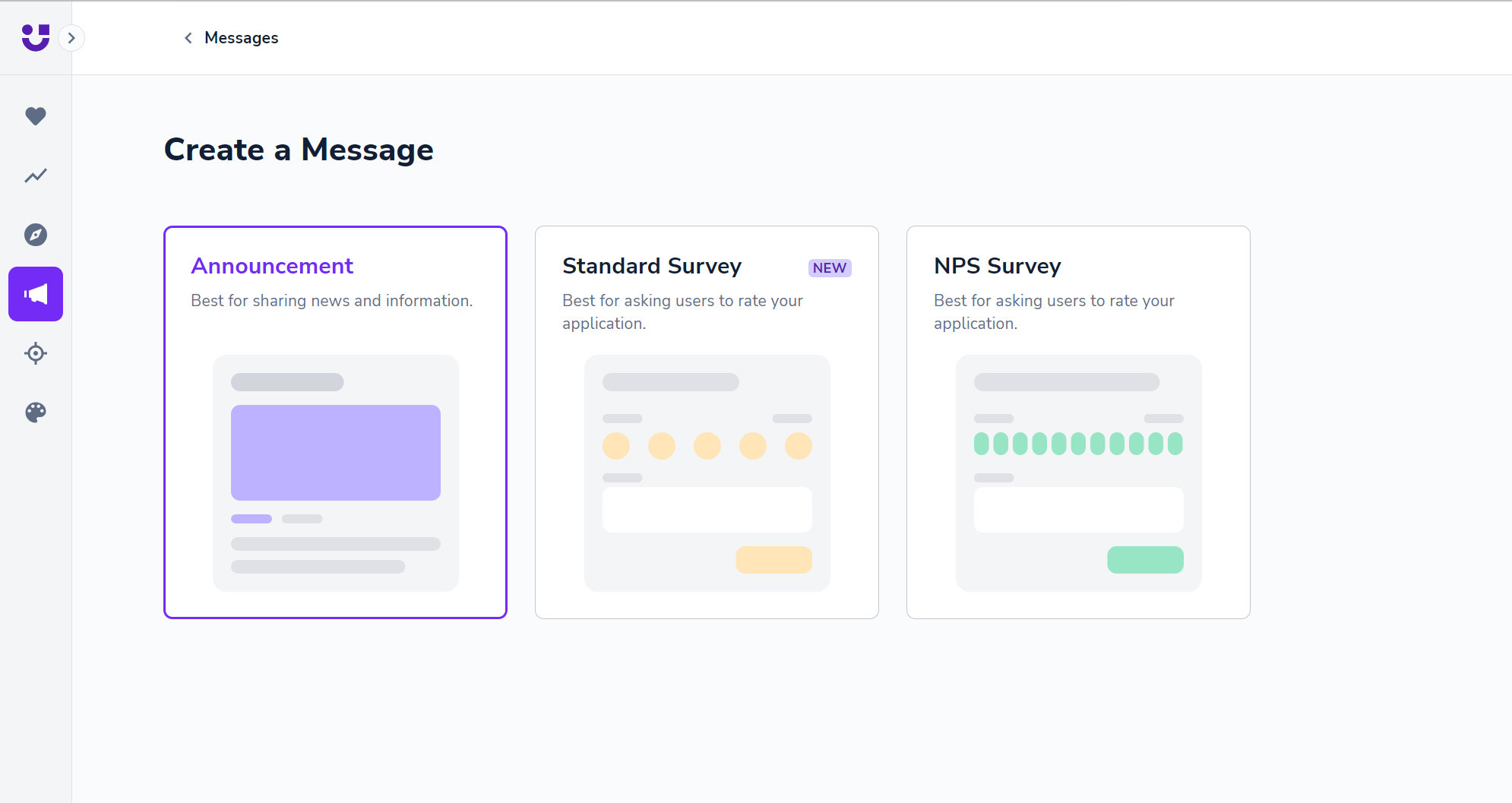
Wondering whether Chameleon or Userlane is the best option for your SaaS company?
This article is going to dive into the Chameleon vs Userlane debate and try to answer a key question: Which is the better tool for user onboarding, as well as other use cases?
In the post below, we’ve covered all the common use cases and done an in-depth analysis of the key features of Chameleon and Userlane – as well as compared it to an alternative solution that may be better in some situations.
Let’s get into it!
Try Userpilot Now
See Why 1,000+ Teams Choose Userpilot

TL;DR
- Let’s explore how Chameleon, and Userlane compare when it comes to user onboarding and other common use cases.
-
- Chameleon is a product adoption platform. It enables SaaS teams to leverage real-time user data to build beautiful on-brand experiences, improve user onboarding, and drive product-led growth.
- Userlane is a no-code digital adoption platform used to measure how employees use applications, identify areas for improvement, and offer real-time guidance directly within any application.
-
- If you’re looking for a better option for user onboarding, Userpilot exceeds both functionality and value for money compared to other tools on the list.
- Userpilot is a product growth platform that drives user activation, feature adoption, and expansion revenue. It also helps product teams collect user feedback, streamline onboarding, and gather actionable insights from analytics. Get a Userpilot demo for user onboarding and drive your product growth code-free.
Userpilot – A Better Alternative for your SaaS

What is Chameleon?
Chameleon is a product adoption platform. It enables SaaS teams to leverage real-time user data to build beautiful on-brand experiences, improve user onboarding, and drive product-led growth.
In addition, it empowers product teams to create and manage dynamic in-product experiences. With Chameleon, SaaS teams can now create beautiful product tours that help, guide, and delight their users throughout their journey. All of these are possible without coding!
What is Userlane?
Userlane is a no-code digital adoption platform used to measure how employees use applications, identify areas for improvement, and offer real-time guidance directly within any application.
In addition, it allows you to get a real-time view of digital transformation progress in your organization. You can now delve deeper into user behaviors across different applications and analyze engagement levels so you can optimize user experiences.
Chameleon vs Userlane for user onboarding
In this section of the article, we’re really going to compare Chameleon vs Userlane in terms of user onboarding. That way, we’ll be able to figure out which tool – Chameleon or Userlane – is the best option depending on your use case.
Chameleon for user onboarding
Users expect to be shown the red carpet with a welcome tour for your product. Chameleon helps you create welcome tours that gets users beyond their first “Aha”.
Here are some features of Chameleon for new user onboarding:
- Segmentation: You can use custom segments to show a sequence of your product tours over time. The hyper-targeted onboarding flows are tailored to your users’ needs. Here’s a short example of what the tour session can look like:
- Clear Analysis: Easily assess and optimize your user onboarding tours with real-time data.
- Launchers: Build onboarding checklists, including items like Loom videos and knowledge base articles to help users unlock more value.
- Customization options: Enjoy fine control over where the onboarding flow appears, choose who sees it, and define how users can interact with it.
Spoiler alert: when you subscribe for the Starter plan, you get access to just one launcher which is very limited for many onboarding use cases. However, you get unlimited access when you pay an extra $971 for the Growth plan.
Userlane for user onboarding
Teams use Userlane to ditch the stress of manual onboarding. The platform allows you to build a customized and interactive onboarding dashboard for each software, promoting an easy software onboarding experience every time.
Here are some ways Userlane helps with onboarding:
- Digital adoption solution: Userlane has a digital adoption solution that provides on-screen, step-by-step guidance to your users. This way, users can navigate your software with ease. You can also create an interactive in-app guide that walks users through tasks, so there’s no steep learning curve or need for external training materials.
- User-specific communication: User onboarding isn’t one-size-fits-all. Everyone’s needs are different. You can customize and improve their walkthroughs and communication based on the user’s behavior and software. Personalized communication makes it easy to remember how to use the features and get help.
- Comprehensive Analytics: Userlane has two applications for user analytics: HEART and Content analytics. HEART is Userlane’s premiere model to monitor software adoption across enterprise apps. The model shows if an application delivers the expected value. And highlights areas teams can improve and optimize. Content Analytics adds a layer of interactivity for guided learning within the platform. This feature allows teams to create guides, tips, and Pop-Ups and host NPS surveys.
Chameleon vs Userlane for product adoption
In this section of the article, we’re really going to compare Chameleon vs Userlane in terms of product adoption. That way, we’ll be able to figure out which tool – Chameleon or Userlane – is the best option depending on your use case.
Chameleon for product adoption
Interacting with users where they’re most engaged – inside your app – is a powerful way to gauge how you can make them stay and love your product. Chameleon is a product adoption platform that helps SaaS teams transform users into advocates by easily creating and implementing in-app messages.
- Step-by-step tours: Guide users through the product with different tours and launchers. This provides an interactive and visually engaging learning process and helps users navigate through the product and increase feature adoption.
- Self-serve launchers: For easy access to resources. By providing quick and easy access to information, you can minimize support tickets and improve customer experience.
- In-product microsurvey: For gathering contextual feedback. These short surveys help gather contextual insights, understand pain points, and identify key areas for improvement.
- Tooltips: For giving real-time guidance. With tooltips, you can provide support to your users without disrupting their experience, and help them overcome hassles without stress.
- Customization options: It offers highly customizable styling, allowing you to create experiences that will match your branding.
Userlane for product adoption
Teams use Userlane to ditch the stress of manual onboarding. The platform allows you to build a customized and interactive onboarding dashboard for each software, promoting an easy software onboarding experience every time.
Here are some ways Userlane helps with onboarding:
- Digital adoption solution: Userlane has a digital adoption solution that provides on-screen, step-by-step guidance to your users. This way, users can navigate your software with ease. You can also create an interactive in-app guide that walks users through tasks, so there’s no steep learning curve or need for external training materials.
- User-specific communication: User onboarding isn’t one-size-fits-all. Everyone’s needs are different. You can customize and improve their walkthroughs and communication based on the user’s behavior and software. Personalized communication makes it easy to remember how to use the features and get help.
- Comprehensive Analytics: Userlane has two applications for user analytics: HEART and Content analytics. HEART is Userlane’s premiere model to monitor software adoption across enterprise apps. The model shows if an application delivers the expected value. And highlights areas teams can improve and optimize. Content Analytics adds a layer of interactivity for guided learning within the platform. This feature allows teams to create guides, tips, and Pop-Ups and host NPS surveys.
Chameleon vs Userlane for customer experience
In this section of the article, we’re really going to compare Chameleon vs Userlane in terms of customer experience. That way, we’ll be able to figure out which tool – Chameleon or Userlane – is the best option depending on your use case.
Chameleon for customer experience
Customer experience is the impression your customers have of your brand based on all of the interactions they’ve had with your business.
Chameleon improves the customer experience in product adoption through features like:
- In-app guidance: Utilizing product tours to improve customer experience. Note that you will need to have CSS knowledge to make styling changes in the Chameleon Builder.
- Personalization through segmentation: Chameleon offers you to personalize user experiences by tailoring product onboarding and in-app experiences for the users most prone to interact and be interested in them. But keep in mind that your segmentation filters are limited compared to other tools like Userpilot.
- User progress tracking: This feature enables you to identify areas where users might be facing difficulties or dropping off due to friction. By tracing user progress, you can scale their experience on your app.
Userlane for customer experience
Userlane is not designed as a customer experience platform. However, it helps create different user segments for each customer depending on their preferences and specific needs.
Using a specialized tool is always going to cost less money and time. That’s why we recommend Userpilot for customer experience—since it’s probably the most cost-efficient product management tool to apply all these tactics (and you don’t need to code).
Chameleon vs Userlane for user feedback
In this section of the article, we’re really going to compare Chameleon vs Userlane in terms of user feedback. That way, we’ll be able to figure out which tool – Chameleon or Userlane – is the best option depending on your use case.
Chameleon for user feedback
Chameleon is a great product feedback tool for gathering contextual feedback inside your app and building an effective and actionable feedback loop.
With Chameleon, you can:
- Create various types of microsurveys: To measure user sentiment regarding new features, product UX and UI, or other in-app experiences created with Chameleon.
- Trigger feedback surveys: Target different custom segments for higher completion rates.
- You get access to basic completion reports: Most of the additional data will need to be analyzed in your analytics tools that Chameleon integrates with and sends data to.
- Personalize the surveys as you wish: You will need help from a developer or may require CSS skills.
Userlane for user feedback
Userlane helps you create interactive tours and guides within your software.
These guides collect feedback from users as they navigate through the application.
This feedback can be through surveys, questionnaires, or specific prompts. The aim is to collect user product feedback, including opinions, suggestions, or concerns about the product. How? Through the following:
- Creates interactive tours to guide users through software.
- Collects feedback via surveys, questionnaires, and prompts.
- Gathers user opinions, suggestions, and concerns about the product.
Chameleon vs Userlane: Which one you should choose?
To further simplify this selection process, let’s break down the strengths and limitations of each tool. Understanding the distinct advantages and potential drawbacks of Chameleon and Userlane will provide you with a detailed roadmap for making a well-informed decision!
Pros and cons of Chameleon
Pros of Chameleon
From a wide array of features to aesthetic UI patterns that can create any flow no matter how customized they need to be, Chameleon is no doubt a powerful tool for scaling product adoption.
It works in a similar way to Userpilot and offers similar features: styling, analytics, templates, goals, A/B testing, and checklists.
Let’s look at the pros of using Chameleon:
- Intuitive no-code builder: Chameleon comes with an easy-to-use Chrome Extension builder.
- Engaging tour guides: Build interactive tours to onboard users, announce features, and create other customer in-product experiences using simple steps.
- Good range of in-app messaging and UI patterns: Easy to create custom modals, slide-outs, tooltips, hotspots, launchers (checklists or resource hub), and more.
- Full two-way and deep analytics integrations: Chameleon fits into your stack, and easily connects with your favorite tools to send data to, and from Chameleon. It offers the deepest integrations, with analytics tools, CRMs, and more.
- Effective segmentation and targeting system: Leverage user data and experiences to structure effective marketing messages and tour guides for a specific target audience.
- Advanced A/B testing: Drive continuous improvement of in-app messages and define the ideal user experience with precise A/B testing.
- Rate limiting: No user wants to be overwhelmed with multiple product tours, in-app messages, and tasks. With rate limiting, you can reduce the number of user experiences — one step at a time, with clarity over speed.
Cons of Chameleon
While Chameleon is a deep production adoption tool with an array of great features, there are still some downsides. Here are the main cons of the tool:
- Not entirely no-code: Early on, we stated that Chameleon can be used without code. True. But it is not a completely no-code tool. You’ll need the help of a technical-savvy employee in your team to sort out some build-up as the learning curve is steeper.
- Hard-to-use interface: The new UI is a bit harder to use (a lot of clicking), and there can be minor bugs here and there.
- Limited experiences: There are some limitations to the user onboarding flows. For instance, you can’t run multiple in-app experiences at the same time, as you can in Userpilot.
- Pricey: The Startup plan is quite expensive (starts at $349/mo for 2500 MAU and includes just one launcher). This means you need to go for the Growth plan, where you pay more but save more at the same time.
Pros and cons of Userlane
Pros of Userlane
Higher productivity, less support effort, and happier users are what Userlane is created for. From a vast spectrum of capabilities to elegantly crafted UI elements that cater to any walkthrough, regardless of its level of customization, Userlane stands out as a robust platform to bolster user engagement and product familiarization.
Let’s dive into the pros of using Userlane:
- Streamlined no-code interface: Userlane boasts a user-friendly dashboard, enabling even those with no coding background to easily design and implement onboarding flows.
- Product adoption analytics: Get a real-time view of digital transformation progress in your organization. Delve deeper into user behaviors across different applications and analyze engagement levels so you can optimize user experiences.
- Dynamic user walkthroughs: Craft compelling and interactive walkthroughs that intuitively guide users through your software, ensuring they grasp every essential feature.
- Versatile in-app communication tools: Whether tooltips, banners, or pop-up modals, Userlane offers many tools to engage users directly within your platform. With Userlane’s customer onboarding solution, you can tailor communications for different user segments, guiding them through the tasks and processes they will most likely need help with.
- Seamless third-party integrations: Integrate Userlane with various analytics tools, CRM platforms, and other essential software to ensure a harmonious workflow and data sharing.
- Granular audience segmentation: Understand your users and their needs better by segmenting them based on behavior, user type, or other customizable metrics. This ensures that your messaging and tours are always relevant and timely.
- Optimized A/B testing capabilities: Refine your onboarding and in-app messaging by A/B testing different approaches, enabling you to continually enhance user experience based on concrete data.
- Thoughtful pacing with walkthrough rate limiting: Ensure users aren’t too quickly bombarded with too much information. With Userlane’s rate limiting, you can pace the introduction of new features or tasks, striking a balance between informing and overwhelming.
Cons of Userlane
As with any tool, weighing its strengths and weaknesses is essential. Here are the notable drawbacks of adopting Userlane:
- Visual Customization Restrictions: One of Userlane’s apparent setbacks lies in its restricted visual customization capabilities. If you have an eye for aesthetic and unique branding elements might find the platform limiting. The lack of diverse templates and somewhat rigid design elements could impede brands from truly reflecting their identity.
- Analytical Ambiguities: In the age of data-driven decision-making, Userlane’s analytical powers — or the lack thereof — stand out. While it offers basic insights, those looking for a deep dive into granular user behavior, funnel analysis, heatmaps, and more might need to bridge the gap with external integrations.
- Integration Quandaries: Speaking of integrations, Userlane might not be the Swiss Army knife of connectivity that some businesses might be hoping for. While essentials like Zendesk, Google Analytics, Hubspot, and Salesforce are on the list, those yearning for a wider array of integration options might need to strategize around these limitations.
- Cost Considerations: Userlane’s pricing structure could be a roadblock, especially for startups and SMEs keen on budget constraints. The initial investment for Userlane might seem daunting, especially considering the added costs of potential integrations and the learning curve associated with maximizing the platform’s potential.
Userpilot – A better alternative for your SaaS
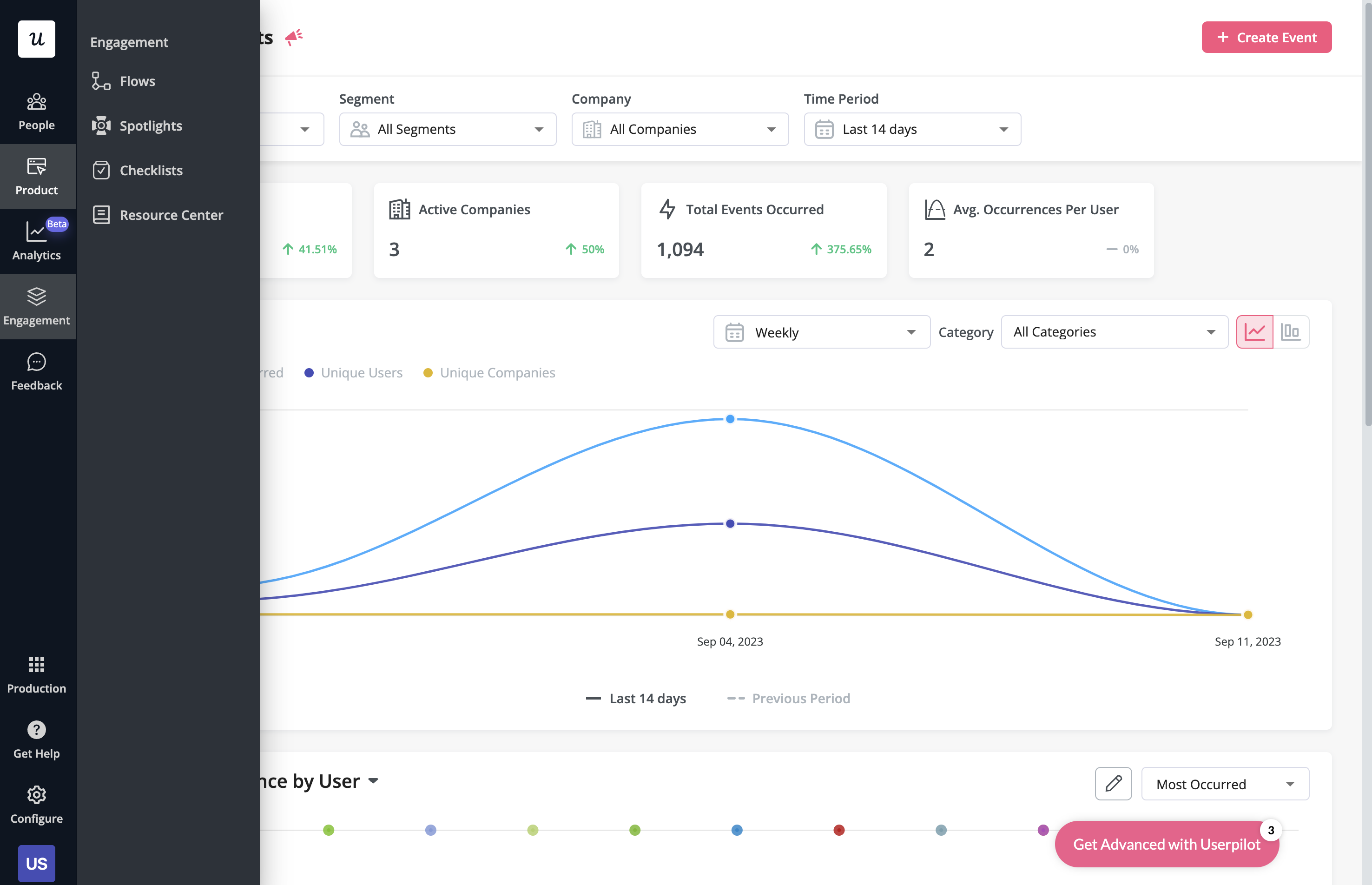
With Userpilot, you’ll be able to track both product usage and user behavior to get a holistic view of how customers use your product — which will guide future development, improve the user experience, and inform your growth efforts.
Pros of Userpilot
As a full-suite digital adoption platform, Userpilot has all the features you need to onboard users, track analytics, and gather feedback from customers without writing a single line of code. Here are a few pros of using Userpilot as your product growth solution:
- No-code builder: Userpilot’s Chrome extension lets you build flows, add UI elements, and tag features without writing a single line of code.
- UI patterns: There are plenty of UI patterns to choose from when using Userpilot, such as hotspots, tooltips, banners, slideouts, modals, and more!
- Startup-friendly: Userpilot’s entry-level plan gives you access to all available UI patterns so you can hit the ground running.
- Walkthroughs and flows: Build engaging interactive walkthroughs and personalized onboarding flows that target specific segments of your user base.
- Self-service support: Build an in-app resource center to help users solve problems, customize its appearance to align it with your brand, and insert various types of content (videos, flows, or chatbots) to keep your customers satisfied.
- A/B testing: Userpilot’s built-in A/B testing capabilities will help you split-test flows, iterate on the best-performing variants, and continually optimize based on user behavior.
- Feedback collection: Userpilot has built-in NPS surveys with its own unified analytics dashboard and response tagging to help you retarget users. There are other survey types to choose from and you can even create your own custom survey.
- Survey templates: There are 14 survey templates to choose from so you can gather feedback on specific features or run customer satisfaction benchmarking surveys like CSAT and CES.
- Advanced analytics: Userpilot lets you analyze product usage data, monitor engagement on all in-app flows, and use the data to create user segments that are based on behaviors instead of demographics.
- Event tracking: Userpilot’s no-code event tracking lets you tag UI interactions (hovers, clicks, or form fills) and group them into a custom event that reflects feature usage.
- Third-party integrations: Userpilot has built-in integrations with tools like Amplitude, Mixpanel, Kissmetrics, Segment, Heap, HubSpot, Intercom, Google Analytics, and Google Tag Manager so you can share data between all the solutions in your tech stack.
Cons of Userpilot
Of course, no tool is perfect and there are a few cons to consider before choosing Userpilot as your user onboarding or product growth solution:
- Employee onboarding: Currently, Userpilot only supports in-app customer onboarding.
- Mobile apps: Userpilot doesn’t have any mobile compatibility which could make it difficult for developers with cross-platform applications to create a consistent user experience for both versions of their product.
- Freemium plan: There’s no freemium Userpilot plan so those bootstrapping their startup and need sub-$100 solutions should consider more affordable onboarding platforms like UserGuiding or Product Fruits.
Conclusion
Hopefully, this post helped you decide whether Chameleon or Userlane is more appropriate for your company. As you can see – both have many upsides and downsides.
Undeniably, Userpilot provides a better value for money and is a better choice for a mid-market SaaS, especially when it comes to user onboarding and user feedback.
If you’re interested in finding more, book a demo with our team here!
Try Userpilot – the Best User Onboarding Solution for SaaS


